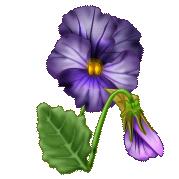 Winter and Spring Annual Flowers - December 3, 2008 Jeff Schalau, Associate Agent, Agriculture & Natural Resources University of Arizona Cooperative Extension, Yavapai County Arizona’s Verde Valley has an intermediate climate that falls somewhere between the warmth of the low desert and the freezing conditions of the mountains. Winter gardening is feasible in the Verde Valley if you select the right crop. Leafy vegetables and root crops can be grown and will even flourish with some frost protection (floating row cover, cold frame, hoop house, and greenhouse). Several annual flowers are equally as cold hardy and can be used to brighten up winter landscapes. The hardiest of winter annual flowers are the pansies and violas. Today's garden pansies and violas are hybrids of several species. The terms pansies and violas are sometimes used interchangeably. Botanically they are all in the same species, Viola x wittrockiana. In common practice, those with 1-2 inch diameter flowers are called violas. Those with flowers over 2 inches in diameter are pansies. Even though violas are smaller in stature, they tend to bear more flowers and tolerate colder weather. Pansies and violas may freeze solid, but most will recover and flower intermittently through the winter and then put on a great show in the spring. Garden pansies and violas come in just about every color combination and new releases are always coming out. They may be a single clear color such as blue or yellow. The single color might also have lines radiating from the center. Or the flowers can be multicolored with a face-like dark blotch. Annual violas include a long-time garden favorite: the Johnny-jump-up (Viola tricolor). Johnny-jump-up flowers have five multicolored petals of violet, white, and yellow with interesting pencil lines or whiskers. These seemingly delicate annual plants grow about 6-10 inches tall and reseed themselves in a manageable, non-invasive way. Another great choice for winter color is ornamental kale. It is technically the same genus and species (Brassica oleracea) as the more familiar broccoli, cabbage, and other cole crops and is very similar genetically to kale grown as an edible green. Plant breeders developed ornamental kales from edible kales by selecting plants with unique foliage colors (white, pink, and red). Ornamental kales are still edible, but they are widely planted for winter foliage color and used for garnishing cooked dishes. Ornamental kale is considered an annual, but botanically it is biennial, meaning its life cycle occurs over two years. The first year it produces vegetative (leafy) growth, and the second year it produces reproductive growth (flowers). Gardeners value it for its vegetative rather than reproductive growth, so practically speaking it is treated as an annual in the garden, being replanted each year. Like pansies and violas, ornamental kale thrives in cold weather. Once plants are acclimatized to the cold, ornamental kale can withstand temperatures as low as 5 degrees F. While violas and ornamental kale have been described in detail, there are several other winter annuals that will perform well in our area. While not a highly attractive plant, stock (Matthiola incana) is cold hardy and produces fragrant flowers in a range of colors. Sweet William is the most common and cold hardy Dianthus (which includes carnations and are often called “pinks”). These hardy biennials come in many colors and are an excellent choice for our area because they prefer alkaline soils. There are many species of poppies (Pavaver spp.) that will tolerate cold weather. Many are planted as annuals, but some will perform as perennials. Iceland poppies are a spring garden favorite and come in many colors. There are many other cool-season annual flowers and foliage plants that can be used to liven up flower beds in winter. Some other ideas may include larkspur (Consolida spp.), forget-me-not (Myosotis sylvatica), dusty miller (Senecio cineraria), cornflower (Centaurea sp.), and candytuft (Iberis umbellata). Many of the above mentioned plants are available from nurseries as transplants during fall, winter and spring. Remember to prepare your soil as you would a vegetable garden prior to planting (see the April 5, 2006 Backyard Gardener on the website). The University of Arizona Cooperative Extension has publications and information on gardening and pest control. If you have other gardening questions, call the Master Gardener line in the Cottonwood office at 646-9113 ext. 14 or E-mail us at cottonwoodmg@yahoo.com and be sure to include your address and phone number. Find past Backyard Gardener columns or submit column ideas at the Backyard Gardener web site: http://cals.arizona.edu/yavapai/anr/hort/byg/. |